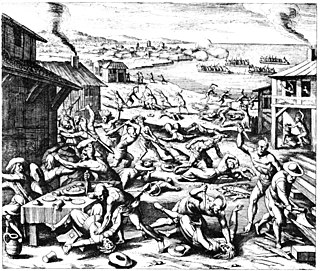Related Research Articles

1626 (MDCXXVI) was a common year starting on Thursday of the Gregorian calendar and a common year starting on Sunday of the Julian calendar, the 1626th year of the Common Era (CE) and Anno Domini (AD) designations, the 626th year of the 2nd millennium, the 26th year of the 17th century, and the 7th year of the 1620s decade. As of the start of 1626, the Gregorian calendar was 10 days ahead of the Julian calendar, which remained in localized use until 1923.

The 1620s decade ran from January 1, 1620, to December 31, 1629.
This article contains information about the literary events and publications of 1626.

John Aubrey was an English antiquary, natural philosopher and writer. He was a pioneer archaeologist, who recorded numerous megalithic and other field monuments in southern England, and who is particularly noted for his systematic examination of the Avebury henge monument. The Aubrey holes at Stonehenge are named after him, although there is considerable doubt as to whether the holes that he observed are those that currently bear the name. He was also a pioneer folklorist, collecting together a miscellany of material on customs, traditions and beliefs under the title "Remaines of Gentilisme and Judaisme". He set out to compile county histories of both Wiltshire and Surrey, although both projects remained unfinished. His "Interpretation of Villare Anglicanum" was the first attempt to compile a full-length study of English place-names. He had wider interests in applied mathematics and astronomy, and was friendly with many of the greatest scientists of the day.
The following entries cover events related to the study of archaeology which occurred in the listed year.
The decade of the 1630s in archaeology involved some significant events.
The decade of the 1620s in archaeology involved some significant events.
The decade of the 1760s in archaeology involved some significant events.
The decade of the 1770s in archaeology involved some significant events.

Giovanni Giustino Ciampini was an ecclesiastical archaeologist.

Francis Drake was an English antiquary and surgeon, best known as the author of an influential history of York, which he entitled Eboracum after the Roman name for the city.
The following is the Jacobite line of succession to the English and Scottish thrones as of the death of Anne, Queen of Great Britain, on 1 August 1714. It reflects the laws current in England and Scotland immediately before the Act of Settlement 1701, which disqualified Catholics from the throne.
References
- ↑ "Ashmolean Museum: British Archaeology Collections - Alfred Jewel". britisharchaeology.ashmus.ox.ac.uk. Archived from the original on 16 March 2017. Retrieved 9 June 2017.
- ↑ "Anne-Claude-Philippe de Tubières, count de Caylus". britannica.com. Retrieved 10 June 2017.
- ↑ "Drake, Francis (1696-1771) Antiquary". nationalarchives.gov.uk. Retrieved 17 May 2017.
- ↑ "Earth Mysteries: John Aubrey (1626-1697)". www.britannia.com. Archived from the original on 24 October 2016. Retrieved 4 June 2017.
- ↑ "Ciampini, Giovanni Giustino 1633-1698". worldcat.org. Retrieved 4 June 2017.